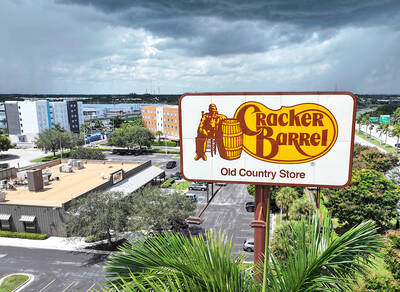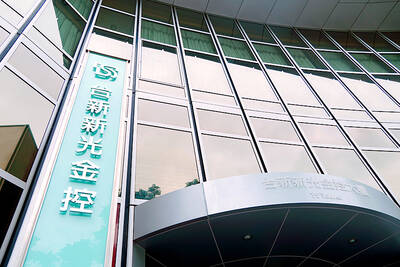Non-fungible tokens (NFTs), the identifiers of the crypto world linked to digital artworks, have been granted a show at the Centre Pompidou in Paris, despite an almost total collapse in their price and cultural cachet.
The Pompidou, a popular attraction in the Marais district of the French capital, has opened the exhibition in its minimalist halls dedicated to NFTs, which could give the digital art form a much-needed lift.
Blockbuster multimillion-dollar sales helped fuel publicity in 2021, and prices soared amid a lack of regulation and general confusion over what the digital tokens were.

Photo: Bloomberg
However, the value of NFT transactions fell 94 percent from 2021 to last year, from US$233 million to US$14 million, French analytics firm Artprice said.
The organizers of the event at the Pompidou, the first European gallery to start a collection of NFT art, are more keen to talk about the art than the economics.
“These artists get a place in the history of art and their works are guaranteed longevity,” the gallery’s chief curator Marcella Lista said.
The collapse in interest in NFTs along with a wider plunge in the value of cryptocurrencies allowed the Pompidou to bag many of the works for just a handful of dollars, records on the OpenSea platform showed.
About half of the pieces were donated by their creators.
Among those who happily handed over their art was Californian artist Robness, who came to see the show and said it was a “humbling experience” to be included.
He, too, was eager to shift the focus from the slump in prices.
“If you start worrying about the market dynamics, you’re taking your energy out, putting it into other places,” he said.
“That’s not conducive to actually creating,” he added.
Robness compared NFTs to e-mail, an elemental technology that he said would continue to find uses.
Born at the crossroads of technology and artistic provocation, NFT art quickly created its own emblems and myths — and the Pompidou exhibition is steeped in its iconography.
Robness donated a 3D “portrait” of Satoshi Nakamoto, the possibly fictional creator of bitcoin.
Another of the works on display is Bitchcoin, a representation of a bitcoin created by Sarah Meyohas in 2015, making it one of the first NFT artworks.
While one of the most famous emblems of the scene, a “cryptopunk,” also gets an airing.
Visitors have the experience of a traditional art gallery — whitewashed walls, hanging images accompanied with small explanation cards — but instead of canvas and paper, the digital works are rendered on screens.
If the prices paid for the artworks were surprisingly low, the gallery nonetheless had to jump through some pretty tight hoops to acquire them.
NFT art is generally sold on platforms where cryptocurrency is the preferred payment method, and proof of ownership is stored on the blockchain.
Lista said that accounting rules simply would not permit the Pompidou to go through the convoluted process of buying cryptocurrency to acquire the works, and blockchain records were not good enough.
Instead, the works were paid for in euros and contracts were signed under French law, she said.
Then comes the difficulty of storing and insuring the works, which are essentially digital pixels that can be replicated as many times as anyone wants.
Philippe Bertinelli, also a curator of the exhibition, said that copies were held on several servers and in different media.
“Even if a system breaks down or something is lost or burned, we can ensure the works are still safely stored,” he said.

On Tuesday, US President Donald Trump weighed in on a pressing national issue: The rebranding of a restaurant chain. Last week, Cracker Barrel, a Tennessee company whose nationwide locations lean heavily on a cozy, old-timey aesthetic — “rocking chairs on the porch, a warm fire in the hearth, peg games on the table” — announced it was updating its logo. Uncle Herschel, the man who once appeared next to the letters with a barrel, was gone. It sparked ire on the right, with Donald Trump Jr leading a charge against the rebranding: “WTF is wrong with Cracker Barrel?!” Later, Trump Sr weighed

SinoPac Financial Holdings Co (永豐金控) is weighing whether to add a life insurance business to its portfolio, but would tread cautiously after completing three acquisitions in quick succession, president Stanley Chu (朱士廷) said yesterday. “We are carefully considering whether life insurance should play a role in SinoPac’s business map,” Chu told reporters ahead of an earnings conference. “Our priority is to ensure the success of the deals we have already made, even though we are tracking some possible targets.” Local media have reported that Mercuries Life Insurance Co (三商美邦人壽), which is seeking buyers amid financial strains, has invited three financial

HEADWINDS: Upfront investment is unavoidable in the merger, but cost savings would materialize over time, TS Financial Holding Co president Welch Lin said TS Financial Holding Co (台新新光金控) said it would take about two years before the benefits of its merger with Shin Kong Financial Holding Co (新光金控) become evident, as the group prioritizes the consolidation of its major subsidiaries. “The group’s priority is to complete the consolidation of different subsidiaries,” Welch Lin (林維俊), president of the nation’s fourth-largest financial conglomerate by assets, told reporters during its first earnings briefing since the merger took effect on July 24. The asset management units are scheduled to merge in November, followed by life insurance in January next year and securities operations in April, Lin said. Banking integration,

Artificial intelligence (AI) chip designer Cambricon Technologies Corp (寒武紀科技) plunged almost 9 percent after warning investors about a doubling in its share price over just a month, a record gain that helped fuel a US$1 trillion Chinese market rally. Cambricon triggered the selloff with a Thursday filing in which it dispelled talk about nonexistent products in the pipeline, reminded investors it labors under US sanctions, and stressed the difficulties of ascending the technology ladder. The Shanghai-listed company’s stock dived by the most since April in early yesterday trading, while the market stood largely unchanged. The litany of warnings underscores growing scrutiny of